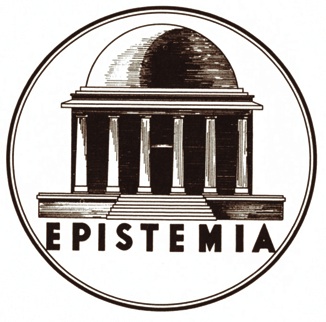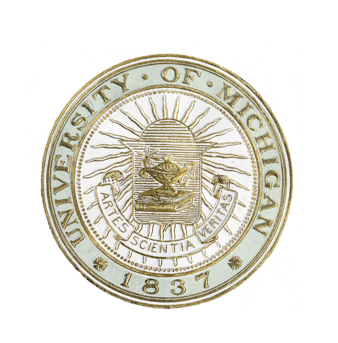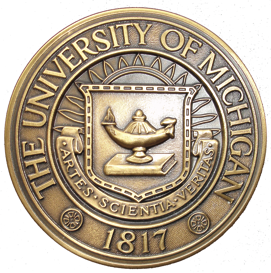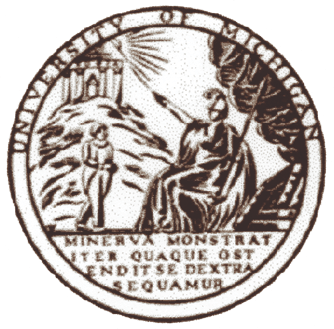THE UNIVERSITY OF MICHIGAN SEALS
The University has had several seals. Its first seal, commonly called the “Epistemia” seal, was adopted September 12, 1817. The Temple of Wisdom Seal—six pillars support a dome—light shines from above on the dome.
On April 5, 1843 the “Minerva” seal was adopted. This seal was used from 1843 to 1896. Minerva is shown pointing a youth to the Temple of Wisdom.
On October 16, 1895, a new seal was adopted by a full vote of the Regents. The Lamp of Knowledge Seal, with a rising sun back of the shield taken from the State of Michigan coat of arms. The “Epistemia” and the “Minerva” seals were fully described. However, the 1895 seal came with no description. It is a fact that there is not a scratch of a pen showing the adoption of 1837 upon the seal of the University, it just “grew up” and made its appearance in 1896 “out of the air!” For the first seventy-eight years of its history the University’s seal was without the date 1837 - the date 1837 is a relatively modern invention. All that the Board of Regents proceedings show upon this subject is that on October 16, 1895, “On motion of Regent Dean, the new seal of the University was adopted by a full vote.” What the new seal was is not shown, which lack of description is in strange contrast with the very full description of the “Epistemia” seal adopted September 12, 1817, and the “Minerva” seal adopted April 5, 1843! If 1837 ever was authorized upon the seal no record of the University shows it!
The only instance where 1817-1837 was discussed by the Regents was back in the 1850s when the enemies of the University argued that the University had no existence prior to 1837 and therefore could not have title to the land deeded by the Federal Government and the Territory of Michigan to its ancestor of 1817. In 1850 the Board of Regents rushed into court and claimed the University was founded in 1817, and by such claim substantiated by the courts managed to retain the University lands! Indeed, the Supreme Court said: “The present University is the same legal body with the University founded in 1817.”
The University of Michigan from its foundation in 1817 until 1867 was supported entirely from its Federal Land Grant endowment and the fees derived from students. In 1867 the Legislature made its first appropriation for the University. “Obviously then until 1867, the institution was not in any sense a state university—it was still a United States Land Grant University.” It is true that the Michigan idea of education, beginning with the University and stretching down through all the lower grades to the primary school, was the pattern for all the other state universities throughout the West, but this idea dates from the University of Michigan of 1817, and it in turn was borrowed from the German and French systems of education in force in 1817 (Harvard Bulletins in Education, Graduate School of Eduction, Harvard University, Number VIII, January, 1923. “University of Michigan: Its Origin and Development” by Richard Rees Price. A.M., published by Harvard University, p. 21).
The Catholepistemiad or University of Michigan of 1817 describes accurately a typical German institution of the day in the quaintly pseudo-classic nomenclature which Jefferson very narrowly failed to saddle upon the entire Old Northwest, and which still remains in such names as Rome, Ithaca, Athens, Sparta, Constantine, etc. No, our idea of a state system of public instruction did not spring into being in 1837, it was embodied in the foundation stature of 1817, and instead of “springing into being” it was borrowed from Germany and France, whereas all the other American institutions of learning up to that time were copied after the English Universities
The Michigan Alumnus
March 23, 1929, Page 463
by Shelby B. Schurtz ’08, ‘10l








